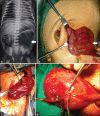Gastrointestinal Duplications: A Decade's Experience
- PMID: 37197242
- PMCID: PMC10185025
- DOI: 10.4103/jiaps.jiaps_108_22
Gastrointestinal Duplications: A Decade's Experience
Abstract
Context: Gastrointestinal (GI) duplications are rare congenital malformations with diverse presentations. They usually present in the pediatric age, especially in the first 2 years of life.
Aims: To present our experience with GI duplication (cysts) at a pediatric surgery tertiary care teaching institute.
Settings and design: It is a retrospective observational study undertaken in the department of pediatric surgery at our center between 2012 and 2022 for GI duplications.
Materials and methods: All children were analyzed for their age, sex, presentation, radiological evaluation, operative management, and outcomes.
Results: Thirty-two patients were diagnosed with GI duplication. Slight male predominance was present in the series (M: F ≈ 4:3). Fifteen (46.88%) patients presented in the neonatal age group; 26 (81.25%) patients were under 2 years. In the majority of cases (n = 23, 71.88%), the presentation was acute onset. Double duplication cysts on opposite sides of the diaphragm were present in one case. The most common location was ileum (n = 17), followed by gallbladder (n = 6), appendix (n = 3), gastric (n = 1), jejunum (n = 1), esophagus (n = 1), ileocecal junction (n = 1), duodenum (n = 1), sigmoid (n = 1), and anal canal (n = 1). Multiple associations (malformations/surgical pathologies) were present. Intussusception (n = 6) was the most common, followed by intestinal atresia (n = 5), anorectal malformation (n = 3), abdominal wall defect (n = 3), hemorrhagic cyst (n = 1), Meckel's diverticulum (n = 1), and sacrococcygeal teratoma (n = 1). Four cases were associated with intestinal volvulus, three cases with intestinal adhesions, and two with intestinal perforation. Favorable outcomes were present in 75% of cases.
Conclusion: GI duplications have varied presentations depending on site, size, type, local mass effect, mucosal pattern, and associated complications. The importance of clinical suspicion and radiology cannot be underrated. Early diagnosis is required to prevent postoperative complications. Management is individualized as per the type of duplication anomaly and its relation with the involved GI tract.
Keywords: Anorectal malformation; associated anomalies; atresia; duplications; gastrointestinal; pediatric.
Copyright: © 2022 Journal of Indian Association of Pediatric Surgeons.
Conflict of interest statement
There are no conflicts of interest.
Figures





References
-
- Keshri R, Prasad R, Chaubey D, Hasan Z, Kumar V, Thakur VK, et al. Duplications of the alimentary tract in infants and children. Formos J Surg. 2021;54:39–44.
-
- Sarin YK, Manchanda V, Sharma A, Singhal A. Triplication of colon with diphallus and complete duplication of bladder and urethra. J Pediatr Surg. 2006;41:1924–6. - PubMed
LinkOut - more resources
Full Text Sources
